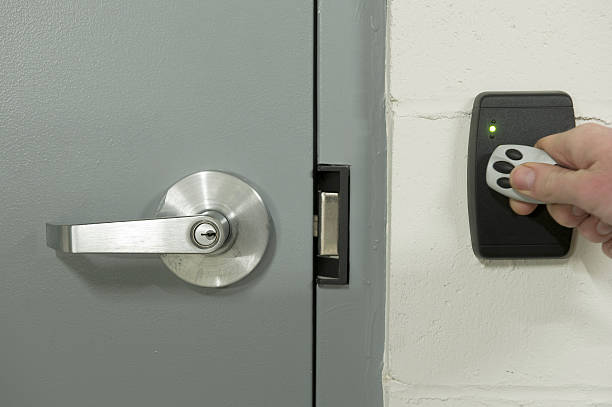Before diving into the guide on rekeying a residential lock, you must know what it means. It certainly does not mean changing the entire lock. Rather, it includes changing pins and springs in the same old lock to unlock it with a different key. This way, anyone with a key to your old lock cannot barge into your house. This is one of the best ways to limit access to your home and update security levels to protect your house from theft or burglary.
Reasons for rekeying a residential lock
There are two times when rekeying a lock seems the best option: when you shift into a new home or want to restrict access to your home for security purposes. The fear of burglars breaking into your house is natural and should be taken seriously. In these times, you need to trust a skilled locksmith who will rekey your installed locks instead of replacing them completely. The process of rekeying a lock is technical. Therefore, consulting with an access control locksmith is pivotal. You can find great safety locksmiths in NYC who will ensure your home is armed with the latest security features and locks.
For instance, you bought a new home for yourself. The previous house owners might have given their maids and other workers access to the locks. This will always keep you in a disturbed state of mind that anyone can break into your house anytime. Not only this, but usually, your keys get stolen or lost, leaving you vulnerable to theft in such situations. This is why rekeying a residential lock is essential in enhancing your house’s and your family’s safety.
Why is rekeying better than replacing a lock?
If the actual concern is safety, then why aren’t we changing the locks entirely in the first place? You are right, but you are unaware of the several benefits of rekeying the residential locks. There are 5 reasons listed below why rekeying a residential lock is a better option than replacing it.
1- Cost-Friendly
It is evident that rekeying involves less expenses than replacing the entire lock because rekeying only requires the internal alterations of the lock. It requires less time and labor, which is more cost effective than installing a new lock.
2- Increased Safety
Rekeying is a simpler, less hectic method to achieve greater security without going through the process of buying and installing a new lock. You can easily ensure that no old keys can open the same lock; hence, your house is protected from all old and duplicate keys.
3- Maintains existing hardware
When a new lock is installed, it also comes with new hardware. You need to change the door knobs, deadbolts, and handles too. This makes rekeying a lock a better and cheaper option than replacing it since old hardware can still be used because no changes are happening in the external aesthetics of the lock.
4- Convenience
Suppose you have lost your key somewhere and are afraid of the possible threat to your home. In such times, you will choose rekeying over replacing because it is quicker yet more efficient to maintain security without worrying for a longer time, which might be the case when replacing the lock.
5- Eco-Friendly
Rekeying a lock is an environmentally friendly option because it does not include discarding old hardware that might cause pollution.
Step-by-Step Guide on Rekeying a Residential Lock
Here’s a comprehensive step-by-step guide for rekeying a residential lock:
1. Collect tools or buy a rekeying kit
If you are rekeying your locks for the first time, you need to collect tools like a screwdriver, key decoder, plug follower, pinning tweezers, new key pins, new springs, and a new key or you can buy a rekeying kit which will have all the tools. When purchasing a rekeying kit, remember that every lock type has its specific rekeying kit. So make sure you have a suitable rekeying kit for your lock.
2. Remove the doorknob
To remove the door, align the holes in the cylinder by turning your doorknob counterclockwise and holding it still. If you find it hard to keep the knob in one place, you can do it by inserting the key and giving it a quarter turn to the right.
Once all the holes are aligned, remove the knob with a remover tool.
3. Remove the lock Cylinder
Using a screwdriver, remove the lock cylinder ( the part of the lock where the key enters) from the door.
4. Remove the cylinder retainer ring and plug
Use the ring remover from your rekeying kit and remove the cylinder retainer ring.
To remove the cylinder plug, insert the key into it and turn it 90 degrees. Now, use the plug follower to push the plug out of the cylinder.
During this step, the upper lock pins and their retaining springs should be in their places because if the upper lock moves from their place, the springs will fall out, and you can’t remove the plug until you put the springs back in using tweezers.
5. Remove Old bottom lock pins and springs
Empty the old bottom pins and springs from the plug.
6. Insert the new key
Insert your new key in the lock cylinder to push the top spring and pin and make way for the bottom pins and springs.
7. Insert New Bottom Pins
Place the new bottom pins into the plug according to the chart provided in your rekeying kit. All the pins are color-coded, so you can insert them where they belong in no time. You can use a tweezer to place the springs.
8. Reassemble Cylinder
Insert the new plug back into the cylinder, ensuring the top and bottom pins align.
9. Time to Test your Lock
Put the cylinder back into the door and test your new key by locking and unlocking the door a few times.
Conclusion
This guide surely would have been a great walk-through for you, increasing your knowledge about when and why you should get your residential locks rekeyed. However, an NY emergency locksmith’s expertise can ensure that your lock is professionally upgraded and ready to be unlocked by your new keys.





























